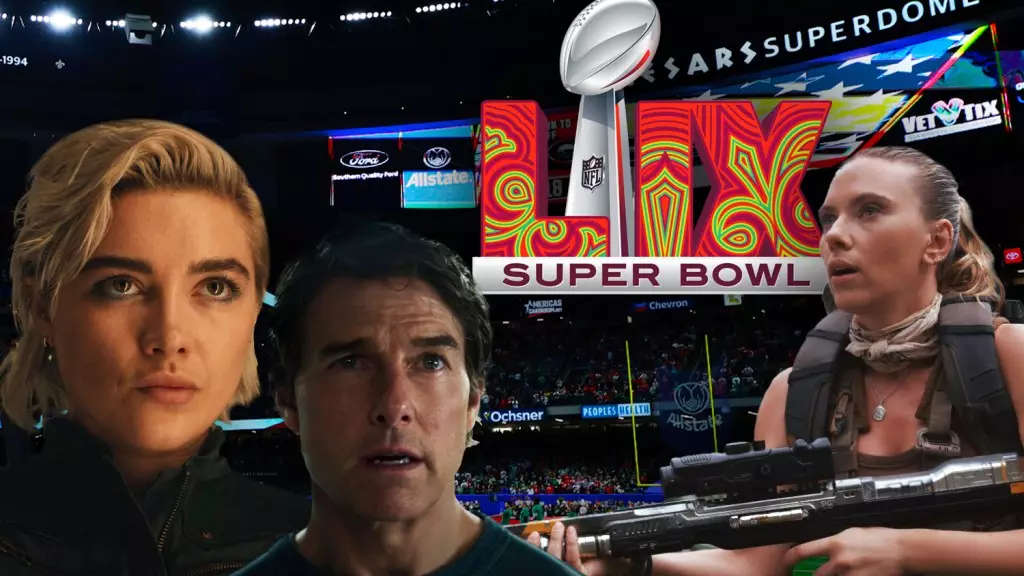The Super Bowl is not just a monumental sporting event; it has become a cultural phenomenon that extends beyond football, encompassing entertainment, marketing, and consumer engagement. With millions of viewers tuning in both live and via streaming services, it serves as a lucrative platform for studios to market their upcoming films. However, delving into the current landscape reveals a notable trend: only three major studios, Disney, Paramount, and Universal, are willing to invest in Super Bowl advertising, despite the hefty price tag hovering around $7.5 million to $8 million for a 30-second commercial spot.
Super Bowl LIX: A High-Stakes Rematch
This year’s Super Bowl, taking place in February, features a thrilling rematch between the Philadelphia Eagles and Kansas City Chiefs. The Chiefs are poised to make history by potentially securing their third consecutive title. This exciting rivalry creates an ideal backdrop for movie studios to entice viewers during one of the largest televised events in the United States. It’s worth noting that while the notion of traditional television viewership wanes, live events like the Super Bowl still attract substantial audiences, particularly for sports programming. For movie studios, the Super Bowl represents a critical opportunity to capture the attention of a wide-ranging demographic.
No discussion of Super Bowl advertising is complete without highlighting Disney’s impressive track record. As the leading studio in 2023 with over $2.2 billion in domestic box office earnings, Disney consistently uses this platform to unveil trailers for its enticing slate of future films. For the upcoming Super Bowl LIX, anticipation surrounds promos for high-profile releases such as *Snow White*, *Lilo & Stitch*, and Pixar’s *Elio*. Moreover, Marvel Studios will also feature clips for their coveted titles, including *Captain America: Brave New World* and *Thunderbolts*.
Historically, Disney has leveraged the Super Bowl to launch significant promotional campaigns. With the power of nostalgia and adventure at its disposal, Disney’s presentations often leave a lasting impression that resonates with viewers long after the game ends. The effectiveness of this strategy is evident from past successes, where films have experienced a noticeable surge in box office performance post-Super Bowl exposure.
Universal Pictures, trailing Disney but still commanding an impressive $1.88 billion at the domestic box office last year, is another seminal player in the Super Bowl advertising sphere. The studio plans to unveil trailers that showcase their upcoming high-profile releases, including a live-action adaptation of *How to Train Your Dragon* and a new installment in the *Jurassic World* franchise. Additionally, Universal has a reputation for surprising audiences with innovative marketing, evident from their previous engagement strategies such as promoting *M3GAN* with extraordinary public displays.
This willingness to innovate is crucial, as it not only builds anticipation around their films but effectively captures the attention of viewers during the Super Bowl’s frenetic pace. Universal’s marketing tactics are a testament to its understanding of both the cinematic landscape and its audience.
Paramount: Consistent Player in the Game
Paramount is no stranger to the Super Bowl and has its own assortment of projects to showcase this year. With titles such as the comedy thriller *Novocaine* and *Mission: Impossible – Final Reckoning*, Paramount aims to maintain its presence and dominate the advertising scene despite the competition. Historically, Paramount has leveraged high-stakes moments during the Super Bowl to tease its cinematic offerings, and this year appears no different.
Despite being outshined by Disney and Universal’s blockbuster titles, Paramount’s strategy reflects a consistent commitment to integrate cinematic promotions into major sporting events. While they may not hold the title of the biggest studio, their contributions to the advertising roster are significant and often highlight diverse genres appealing to a varied audience.
What Lies Ahead for Other Studios?
Interestingly, the absence of studios like Sony, Warner Bros, Netflix, Amazon, MGM, and Lionsgate from the Super Bowl advertising lineup is noteworthy. In recent years, Warner Bros has shied away from robust Super Bowl campaigns, having last made a splash with *The Flash*. The shift in strategy from these studios indicates a possible reevaluation of marketing approaches in the current entertainment landscape, with many opting to allocate resources elsewhere or rely on less conventional venues to promote their films.
Overall, as the Super Bowl approaches, the stakes remain high for those participating in the advertising drama. The need to creatively captivate an audience with upcoming film trailers makes this event a critical juncture for major studios, as they seek to engage a captive audience with stories that echo beyond the confines of the football field. With the convergence of entertainment and sports, the Super Bowl continues to serve as a vibrant stage for cinematic promotion, illustrating the powerful relationship between media, culture, and consumerism.

